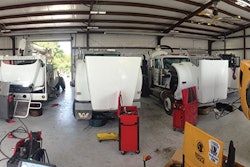
One established recruitment and retention strategy growing in popularity in the trucking industry is apprenticeship programs. These traditional career training and preparation courses are typically built in conjunction between a service center and technical education partner, such as a local vo-tech school.
When done well, apprenticeship programs (also sometimes referred to as internships) provide tech students invaluable insight on the day-to-day experience of working in a diesel service shop, including common repairs, management styles, employee expectations and overall corporate culture. However, when done poorly, these programs can send talented potential technicians hurtling away from the trucking industry before earning their first full-time paycheck.
To make an apprenticeship program worthwhile, experts say it’s important to devise a plan that’s simple, transparent and educational. Even the best apprentice or intern is still a student first and should be treated as such.
Affinity Truck Center Service Manager Chris Paris says that’s something his team took to heart in developing its apprentice and internship programs. Introduced six years ago, Paris says Affinity built the two programs as tools to recruit, train and retain young people considering a technical career.
“We’ve attacked the [tech] shortage from so many different angles but, eventually, we realized if we really wanted to solve our problem, we had to build something ourselves,” he says.
Paris and Training Manager Bob Blanchard describe the programs as follows: The internship program is a once-a-week, on-site program for area high school students enrolled in vocational education courses; the apprenticeship program is a two-year comprehensive training course Affinity uses to onboard its tech hires new to the industry.
Regarding the latter, the duo say strong students occasionally complete the course in less than two years but spend at least 18 months in three distinct positions. Affinity’s existing techs are involved, too, serving as mentors and educators throughout the process.
That inclusion has been key to the program’s success and something Paris says he’d recommend to any other service provider considering such a program.
“I think when you start asking you find out a lot of senior techs are kind of bored. They’ve been doing the same jobs for years,” he says. “Our guys welcomed the challenge as something new and exciting.”
Blanchard adds “it’s a huge sense of pride” for existing techs to see their apprentices graduate up into the business.
Apprentice programs also work best when some time is set aside for students to learn about their employer outside of the service bay.
Both Affinity interns and apprentices are introduced around their facilities early in their programs, and then are briefed on different department responsibilities at points during their time at the business.
“We try to give them a little bit of insight about what it would be like to work here,” Paris says.
Finally, honesty is another necessity when building an apprenticeship program. A tech student should always experience a service provider’s workplace like it really is — not some fictionalized or idealized version that doesn’t accurately reflect how the business operates when the student leaves.
Adds Paris, “We want our apprentices to be able to make an educated decision about if they want to do this as a career or not.”
Click here to download the Randall-Reilly technician wage survey
TARGETING TECHNICIANS, PART 3
Stemming the turnover tide: Investment in your business can help retain your best technicians
Want technicians to stay at your shop? You better pay
Knowledge is power: Technician apprenticeship programs can increase retention rates
Workplace culture can be a technician retention tool
Millennials aren’t from Mars: Generational perceptions impact technician retention












